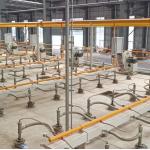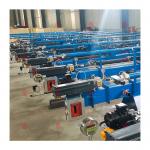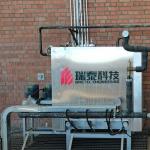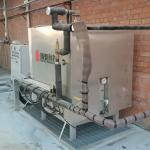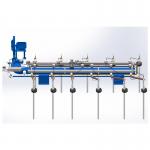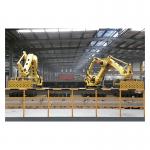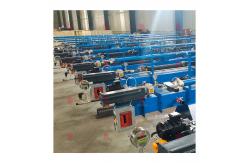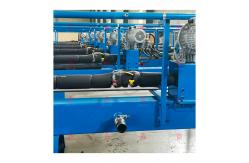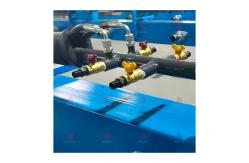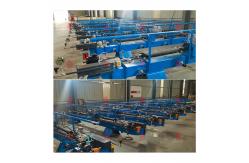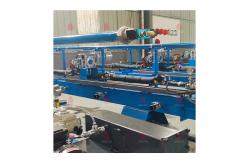Data of product | No. | Feature | Details |
|---|
| 1 | Kiln Temperature and Energy Consumption | Uniform kiln temperature and low energy consumption | | 2 | Product Appearance and Strength | The fired products with uniform appearance color and high product
strength | | 3 | Burning System | Automatically controlled burning system for precise kiln
temperature | | 4 | Applicable Products | Suitable for high-end products such as decorative bricks and
insulation blocks | | 5 | Ignition System | Equipped with automatic ignition system | | 6 | Burner | Automatic ignition burner with flame control system | | 7 | Safety Component | Safety solenoid valve | | 8 | Regulating Valve | Natural gas and air input regulating valve | | 9 | Burner Power | Each ordinary burner power is 40kW - 70kW (35000kcal - 60000kcal),
each automatic ignition burner power is 60kW - 150kW (50000kcal -
125000kcal) | | 10 | Applicable Fuels | Natural gas, oil, coal , etc. |
Benefits of Using Natural Gas Combustion Systems in Brick Factories - Precise Temperature Control
- Natural gas combustion systems can achieve precise temperature
control.The natural gas combustion system, through advanced burners
and control systems, can accurately adjust the flame size and
temperature to ensure that the brick blanks are in a suitable
temperature environment at each stage, making the quality of the
bricks more stable.
- Compared with the traditional coal combustion method, the
temperature fluctuation of coal combustion is relatively large and
difficult to control precisely. This may lead to quality problems
such as cracks and deformation of the bricks, while natural gas
combustion can effectively avoid these situations.
- Good Firing Uniformity
- The flame generated by natural gas combustion is relatively
uniform. The combustion process involves fully mixing air and
natural gas in the burner before combustion, and the flame can be
evenly distributed inside the kiln. This ensures that the brick
blanks are heated evenly at all positions inside the kiln, avoiding
local overheating or underheating.
- For example, when using a natural gas combustion system in a tunnel
kiln, the brick blanks slowly pass through the kiln on the conveyor
belt, and the uniform flame can ensure that each brick is fired to
the same extent, thereby improving the quality consistency of the
entire batch of bricks. The performance indicators such as the
color and strength of the products are more uniform.
- Beautiful Product Color
- Natural gas combustion produces fewer impurities. When firing
bricks, it will not have a large amount of coal ash and other
impurities adhering to the brick surface like coal combustion does.
This makes the brick surface smoother and the color more pure.
- For example, for some colored bricks or fair-faced bricks used for
the exterior decoration of buildings, using natural gas for firing
can better present the colors required by the design, improving the
aesthetics of the products and enhancing their competitiveness in
the building materials market.
- Reduction of Pollutant Emissions
- Natural gas is a relatively clean energy source. The combustion of
natural gas mainly produces carbon dioxide and water, and hardly
generates pollutants such as sulfur dioxide, nitrogen oxides, and
particulate matter. Compared with coal combustion, the sulfur
dioxide emissions during natural gas combustion can be reduced by
more than 90%, the nitrogen oxides emissions can be reduced by 50 -
60%, and the particulate matter emissions are significantly
reduced.
- This is very important for improving the air quality around the
brick factory. Especially with increasingly strict environmental
regulations, using a natural gas combustion system can make it
easier for the brick factory to meet environmental standards and
reduce the risks of fines and rectification due to environmental
pollution.
- Potential for Greenhouse Gas Emission Reduction
- Although the combustion of natural gas also produces carbon
dioxide, from a life-cycle perspective, the carbon dioxide
emissions per unit of energy generated are lower than those of
traditional fuels such as coal. Moreover, with the continuous
progress of natural gas exploration and transportation
technologies, its carbon footprint has the potential to be further
reduced.
- In the context of the global response to climate change, the use of
natural gas combustion systems in brick factories helps to reduce
greenhouse gas emissions, fulfill the corporate social
responsibility, and enhance the green image of the enterprise.
- High Combustion Efficiency
- Natural gas and air can achieve good premixing in the burner,
making the combustion more complete. The combustion efficiency can
generally reach more than 90%. In contrast, the combustion
efficiency of coal is usually around 60 - 80%.
- This means that under the requirement of the same heat output, less
fuel is needed when using natural gas, which can reduce production
costs. Meanwhile, efficient combustion can also heat the kiln to
the required temperature more quickly, shortening the firing cycle
of bricks and improving production efficiency.
- High Degree of Automation
- The natural gas combustion system can be equipped with advanced
automatic control equipment. Through sensors, controllers, and
actuators, automatic adjustment of the combustion process can be
achieved, including real-time monitoring and adjustment of
parameters such as gas flow, air flow, flame size, and temperature.
- For example, when the temperature inside the kiln deviates from the
set value, the control system can automatically adjust the supply
amounts of natural gas and air to quickly restore the temperature
to the normal range. This automatic control not only improves the
stability of the production process but also reduces the need for
manual intervention, lowers the labor intensity, and makes the
production management of the brick factory more convenient and
efficient.
- Stable Supply
- Natural gas is transported through pipelines. As long as a stable
supply contract is signed with the gas supplier, generally there
will be no situation like the interruption of coal supply affected
by transportation, weather and other factors. This can ensure the
continuity of the brick factory's production and avoid production
losses caused by insufficient fuel supply.
- Good Safety
- The natural gas combustion system itself has certain safety
designs. For example, natural gas pipelines usually have complete
leakage detection devices. Once a leak occurs, it can give an alarm
in time and take measures. Moreover, the safety during the storage
and transportation of natural gas is relatively high. Compared with
the risks such as spontaneous combustion during coal storage, the
potential safety hazards of natural gas are relatively small.
|
